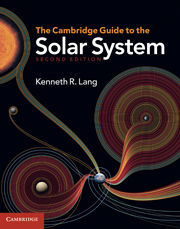Crossref Citations
This Book has been
cited by the following publications. This list is generated based on data provided by Crossref.
Pasachoff, Jay M.
and
Filippenko, Alex
2013.
The Cosmos.
Joan Williamson
2015.
The Planets: A Definitive Visual Guide to Our Solar System.
Reference Reviews,
Vol. 29,
Issue. 7,
p.
40.
Privitera, Giovanni
Meynet, Georges
Eggenberger, Patrick
Vidotto, Aline A.
Villaver, Eva
and
Bianda, Michele
2016.
Star-planet interactions.
Astronomy & Astrophysics,
Vol. 591,
Issue. ,
p.
A45.
Pierson, Ashlyn E.
and
Clark, Douglas B.
2018.
Engaging students in computational modeling: The role of an external audience in shaping conceptual learning, model quality, and classroom discourse.
Science Education,
Vol. 102,
Issue. 6,
p.
1336.
Gohardani, Amir S.
and
Staab, Michael
2019.
Mission to Saturn: An Exemplary Collaboration between NASA and International Rectifier HiRel Products.
Lowrie, William
and
Fichtner, Andreas
2020.
Fundamentals of Geophysics.
2020.
Fundamentals of Geophysics.
p.
1.
Ahrens, Caitlin
2021.
Encyclopedia of Lunar Science.
p.
1.
Coustenis, Athena
Fulchignoni, Marcello
and
Roques, Françoise
2021.
The Solar System 2.
p.
1.
Rotmanas, Algimantas
2022.
Geoterminės energetikos technologijos.
von Kusserow, Ulrich
and
Marsch, Eckart
2023.
Magnetisches Sonnensystem.
p.
1.
Rovira-Navarro, Marc
Matsuyama, Isamu
and
Hay, Hamish C. F. C
2023.
Thin-shell Tidal Dynamics of Ocean Worlds.
The Planetary Science Journal,
Vol. 4,
Issue. 2,
p.
23.
Palos, Mario
Janhunen, Pekka
Toivanen, Petri
Tajmar, Martin
Iakubivskyi, Iaroslav
Micciani, Aldo
Orsini, Nicola
Kütt, Johan
Rohtsalu, Agnes
Dalbins, Janis
Teras, Hans
Allaje, Kristo
Pajusalu, Mihkel
Niccolai, Lorenzo
Bassetto, Marco
Mengali, Giovanni
Quarta, Alessandro
Ivchenko, Nickolay
Stude, Joan
Vaivads, Andris
Tamm, Antti
and
Slavinskis, Andris
2023.
Electric Sail Mission Expeditor, ESME: Software Architecture and Initial ESTCube Lunar Cubesat E-Sail Experiment Design.
Aerospace,
Vol. 10,
Issue. 8,
p.
694.
Ahrens, Caitlin
2023.
Encyclopedia of Lunar Science.
p.
655.
von Kusserow, Ulrich
and
Marsch, Eckart
2023.
Magnetisches Sonnensystem.
p.
209.
Cinelli, Marco
Ortore, Emiliano
Mengali, Giovanni
Quarta, Alessandro A.
and
Circi, Christian
2024.
Lunar orbits for telecommunication and navigation services.
Astrodynamics,
Vol. 8,
Issue. 1,
p.
209.





